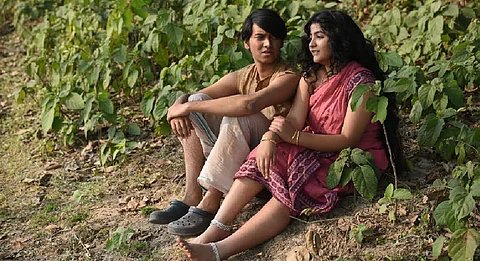
- Reviews
- Power List 2024
- Cannes 2024
- In-Depth Stories
- Web Stories
- News
- FC Lists
- Interviews
- Features
- FC SpecialsFC Specials

Cottage cheese kneaded into a dough of medium-sized balls, dipped in sugar syrup and cooked over a medium flame. The cheese balls are then allowed to cool in the syrup. Those two prosaic sentences contain the essence of making that king of all sweets, the rosogolla. Making a film on the life and times of Nabin Chandra Das, creator of the rosogolla, is an entirely different ball-game altogether. "The idea for the film came over an adda with Smaranjit-da (novelist Smaranjit Chakraborty). We were discussing essential 'Bangaliana' and realized that the rosogolla is probably the one thing that unites Bengalis all over the world," says Pavel.
While that adda triggered the idea, it was Nabin Chandra Das's character that ultimately drew Pavel to making the film. A man, twenty-three years old, trying to make a sweetmeat, not to invent just another dessert but to keep a promise he had made to his beloved wife. "Failure, misfortune, insult, nothing could stop him. At the same time, he was so selfless that he never hesitated in teaching others how to make rosogolla. I also discovered that he was an exceptional khol player and a music lover. While N.C. Das was interesting, what actually struck me is Khirodmoni Devi, his wife. She had the courage and guts to run a business in that era," says Pavel.
N.C. Das died in 1925 at the age of 80. The film traces his life from the age of 6 to about 32-33, when he set up the first outlet in Kolkata and came to be known as Nabin Moira. What were the challenges in creating the Kolkata of 1845 to 1868 when the sweet was first made? "Reading about the era and recreating in figures and forms what I read on paper was a challenge. Works like Hutum Pechar Noksha, Alaler Gharer Dulal, Nildorpon, Komolakanter Doptor provided information about the times. I frequented the Kolkata Museum, the Town Hall, studied paintings by Thomas and William Daniels, went through the Calcutta Gazette." The film-maker also had a team of renowned historians and dedicated researchers who helped him draw a map of Kolkata of the 1800s, complete with by-lanes, markets, houses and water carriage system.
Producer Shiboprosad Mukhopadhyay also credits three-time National Award-winning production designer Nitish Roy for the film's authentic look. "It is the magic of Nitish. The cinematography, the production design and the music (the legendary Kalika Prasad's last work) have come together to create what is the most important film of the year."
What also helped the research was the association of the descendents of Nabin Chandra Das, primarily Dhiman Das, director of K.C. Das Sweets. "I sent the final draft of the script to them and they had valid inputs which we incorporated," says Pavel. Rosogolla Bhavan, the ancestral place of the sweet-maker's family in Baghbazar, has been part of the location shooting.
While the film boasts a cast of stellar character actors, including Kharaj Mukherjee, Shantilal Mukherjee, Koushik Sen, Rajatava Dutta and Aparajita Adhya, what has piqued interest is the casting of Ujaan Ganguly as Nabin Chandra Das. Ujaan is the son of well-known film-maker Kaushik Ganguly. "We had a number of auditions but none of them was satisfactory. It was Nandita-di (producer Nandita Roy) who told me of Kaushik-da and Churni-di's son. I met him and liked him. For a first-timer, he will leave you spellbound."
"Failure, misfortune, insult, nothing could stop him (Nabin Chandra Das). At the same time, he was so selfless that he never hesitated in teaching others how to make rosogolla," says Pavel.
For Shiboprosad, producing Rosogolla was a no-brainer. "At Windows Production, we have been regularly introducing new talent, and Ujaan and Abantika (who plays Khirodmoni Devi) are part of the process. It's my way of giving back to the industry. When I was a newcomer, Rituparna Sengupta backed me, Rakesh Singh produced my first project, Raja Dasgupta gave me my first serial to direct. Today, Nandita and I are in a position to do the same for other newcomers. Audiences have complete faith in us and know that if we are involved, definitely kuch toh hai project mein," he says.
As a country, we rarely get biopics right because we tend to take fictional liberties. Pavel has called Rosogolla a "fictional biopic". "I am a writer and a storyteller. To me a film is not just a reflection of truth but my interpretation of the truth. A film, like any other literary medium, should be able to engage its audience. If that necessitates taking some creative licence, so be it. There are a couple of fictional characters I have incorporated for the sake of the narrative. However, I took no liberties in creating the period and have tried to be as authentic as possible," he says. If, as Pavel puts it, Bengali equals Rosogolla, audiences in Bengal are in for a sweet Christmas.
(With inputs from Soujannya Das)